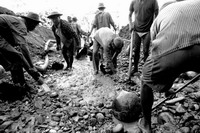Login form
Gold Rush of 1849

In 1849, one word sent thousands of people scrambling on a dangerous journey to California: GOLD! A worker at John Sutter’s sawmill in California’s Sacramento Valley discovered gold there in January 1848. The word spread across the country like wildfire. The news flew to faraway China and Europe. The gold rush was on!
HOW PEOPLE GOT TO CALIFORNIA
The journey west to California wasn’t easy in those days. Many Forty-Niners, as the gold seekers were called, traveled by boat. Some sailed around the tip of South America (called Cape Horn) and up to California. A large number of ships sank on this dangerous voyage. Others sailed to Panama, traveled on land to Panama City, and then hopped on another boat to San Francisco.
But most people walked or rode on horseback several thousand miles to the California gold fields. Gold seekers followed such routes as the Oregon Trail and the Mormon Trail across the Great Plains. People faced harsh conditions: burning heat, rain and snow, lack of water, and steep mountains to cross. Cholera and other diseases killed thousands of Forty-Niners before they ever reached California.
People braved these hazards because they dreamed of striking it rich. The promise of gold lured over 200,000 people to California in just a few years.
HOW THE FORTY-NINERS FOUND GOLD
Most Forty-Niners were men. They crowded into muddy mining camps, sleeping in flimsy shacks or tents.
Miners spent their days digging for gold. In the early days of the gold rush, a man could pocket $300 or $400 in gold before supper—a fortune at the time! Miners also panned for gold in streams and rivers, gathering dirt and rock in metal pans. Water washed away the dirt and left the heavier gold in the pan.
Not everyone found gold. In fact, most people’s dreams of quick riches never came true. In 1851, mining began shifting into a business run by companies.
HOW THE GOLD RUSH CHANGED AMERICA
Gold fever brought a huge wave of people into the West. New Western settlements sprang up almost overnight. Some became abandoned ghost towns after the gold rush, but others survived. These early settlers helped California grow in its first years of statehood.
The gold rush also pumped billions of dollars into the United States economy. This money helped build railroads and factories, establishing America as a nation of industry.
Source: Microsoft ® Encarta

